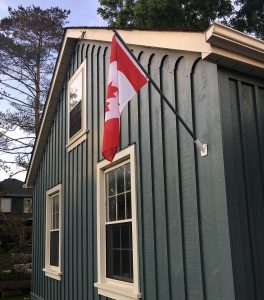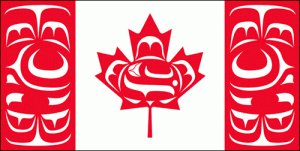
A few weeks after the storm, amid our yard debris, I found the tattered remains of the Canadian flag that had hung over the entrance to our house for a number of years. The state of the cloth – shredded and torn by the fury of the storm – inspired me to buy a new Red Maple Leaf (albeit a smaller one than usual) and hang it outside our home. One of my neighbours noticed that the replacement flag looked a bit different.
“Your other one was a lot bigger,” he pointed out. “Why a smaller Maple Leaf?”
I shrugged and said, “For the moment, that was the only size I could find.” But what I didn’t say to my neighbour at the time was that these days I’m a bit conflicted about displaying national emblems, and in particular the Canadian flag in anything that looks like a grandiose statement.
I certainly didn’t want my nod to the Red Maple Leaf to imply, for example, that I endorse the attitudes or actions of last winter’s so-called “Freedom Convoy” in Ottawa.
Nor, on the other hand, did I wish to ignore what to some people represents a symbol of colonialism or white supremacy, especially with Canada Day this week. I do not consider my respect for one of Canada’s national symbols as an endorsement of anti-vaccine protest nor of the oppression of Indigenous rights and freedoms.
It is love of country. It’s that simple.
In early February, we witnessed our flag paraded alongside what amounted to a rudderless mob claiming to represent the majority of truckers not in favour of vaccination mandates. (The truth was 90 per cent of Canadian truckers were vaccinated.) We watched thousands of protestors clog the national capital with idling vehicles, pop-up food shacks and jerry-can fuel brigades.

They filled the streets with pointless honking, engine exhaust and chants of insurrection, all while parading their ill-founded demands with racist symbolism, placard illiteracy and populist rhetoric calling for the overthrow of a freely elected federal government.
At least one demonstrator carried an upside-down Canadian flag desecrated with a Nazi swastika and anti-Trudeau slogans.
The “F—K Trudeau” epithet adorns at least one pickup truck in this community and its driver regularly flies an oversized Canadian flag when driving around town.
Since when does that represent civilized political discourse in this country? What kind of message does such an abusive display send to the driver’s children? And while I often defend all citizens’ rights to protest in this column, I see marrying a national symbol with that kind of vitriol as careless if not criminal.
In the state of New York since 2020, the sale or display of Confederate flags, swastikas or other “symbols of hate” is banned.
“You don’t have a right to conduct yourself in a violent manner and call that expression,” said Eric Adams, University of Alberta law professor. “But even something as hateful as a Nazi flag or a Confederate flag … are still acts of speech rather than acts of violence – at least in the characterization of our jurisprudence.”

The Red Maple Leaf, which since 1964 has represented the Canadian nation, to some Indigenous communities does not acknowledge that the country, in their words, “exists on stolen land.” Ideas have come and gone as to how to incorporate the identities of Indigenous nations into the national flag; one, designed by Indigenous artist Mulidzas-Curtis Wilson, even retained the red maple leaf flanked by red stripes, but with Indigenous symbols embedded within.
Other Indigenous leaders have invited their communities to create flags for display on Indigenous territory as well as the Red Maple Leaf.
“I think that may be a better approach,” suggested flag scholar David Roger-Gagnon, “rather than trying to stick a feather on a provincial flag and say that we’ve been inclusive.”
However, I’m old enough to remember the flag that emerged from the Oka Crisis in the summer of 1990. The warrior flag, created in 1974, was intended to be a symbol for all Indigenous people to stand behind, but ultimately was redesigned as an emblem or resistance. Flags express different things for different people.
Which brings me back to the new Red Maple Leaf fluttering from the front of my house in time this week for Canada Day. For me it represents 58 years as a flag, but 155 as a unique nation. I say “unique,” but not “perfect.”
National symbols cannot account for misguided policies, such as residential schools. But they can represent a confederation whose roots are both Indigenous and immigrant in origin, while always representing the hope of unity through civilized debate for all who call Canada home.